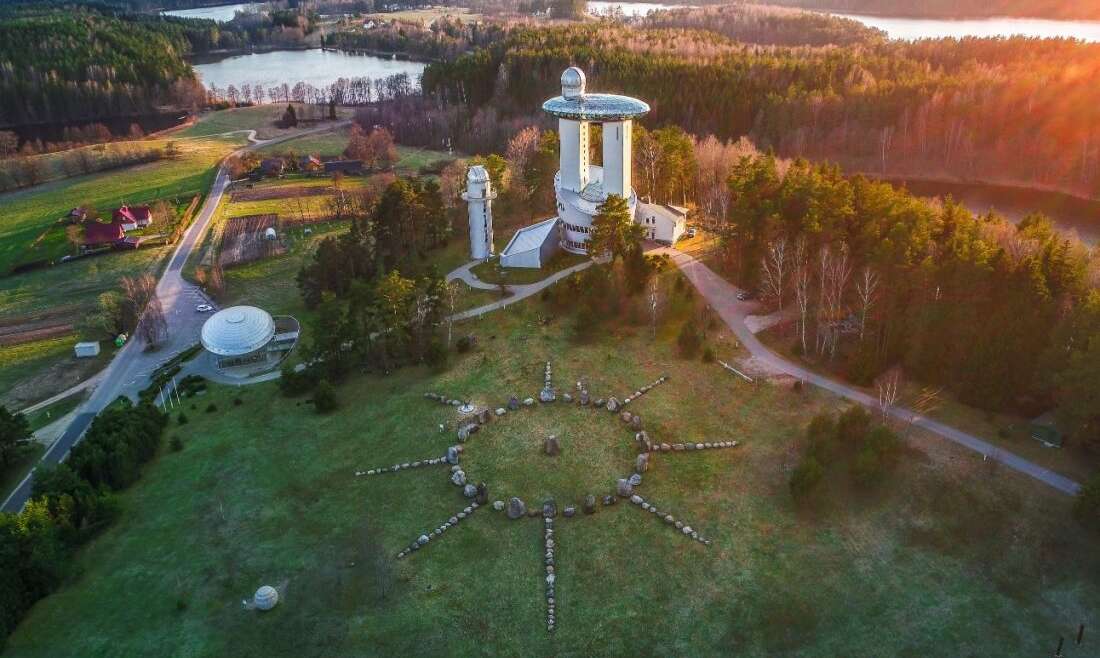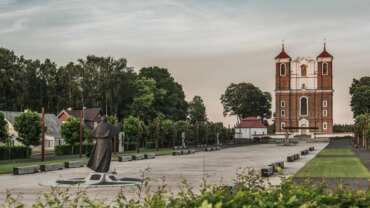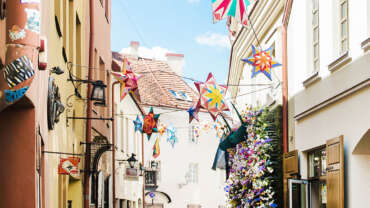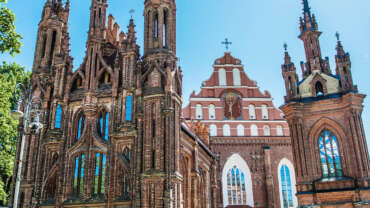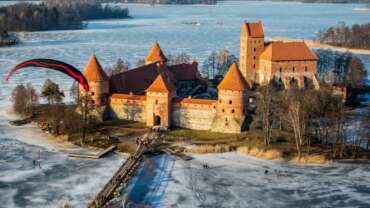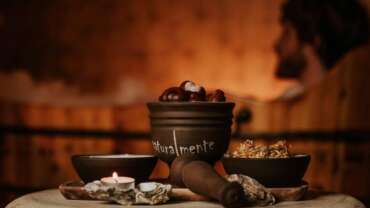Ethnographic Regions of Lithuania
If you decide to spend at least a week in Lithuania, you can do a lot. Select the vehicle of your liking – whether it’s a bike, motorcycle, car, bus or train – and set out to explore Lithuania’s ethnographic regions. And they are all very different.
Dzūkija
In the south-eastern part of Lithuania, between the forests and the wetlands, between the sandy hills and the lakes hidden in the woods, live the people of Dzūkija, who can boast of their old traditions, their remarkably preserved neighbourly customs, their love of the environment and all living things, and their mushrooms and berries. The authentic villages grouped together in the woods are an amazing opportunity to go back a century, feel the power of the forest, and immerse yourself in the tranquil, slow life of nature.
Dzūkija. Things to do
People who live in Vilnius are sometimes surprised to be called Dzūkians. But in fact, Vilnius – as well as the nearby historical capital of Lithuania that is famous for its lakes, Karaim and Tartar dishes, and the beautiful Trakai Castle – are geographically located in the region of Dzūkija. You won’t be able to cover Dzūkija in a few days – save time for Baroque Vilnius and enjoy the tranquillity of Trakai, and only then travel on towards Alytus and Merkinė, and the resorts of Druskininkai and Birštonas, with their abundant mineral springs and fresh pine air. If you want to get some exercise and give your mind a rest, look around for boat or kayak rentals. A trip down the swift Ūla River could become the biggest adventure of your trip. And be sure to see for yourself what it means to pick a basket-full of wild blueberries in the forest on a hot summer day, or count the brown-capped bolete growing under an oak tree. If you dare – go to the marsh in the Čepkeliai Nature Reserve, which is one of the largest marshlands in Western Europe. Spectacular photos are guaranteed!
Dzūkija. The people and the culture
There is no mistaking the Dzūkian dialect. Even those who don’t understand Lithuanian will catch the constant sound of “dz”. There is a saying in Lithuania that “if the mushrooms and berries weren’t there, the girls of Dzūkija would all be bare”. And nobody gets angry about it because indeed – for many people in Dzūkija, the mushrooms that grow in the thick of the forests, the berries that ripen in the sunny glades, and the honey brought by bees are their business and life, and the thing that puts food on the table. Just like their hospitality, generosity and desire to show off the best of what they have in their region – nature, authentic crafts, and resounding songs. If you want to find out how people lived in wooden houses in nature’s refuge more than a hundred years ago, travel to Dzūkija.
Dzūkija. The food
One thing is for sure – the people of Dzūkija know how to put the gifts of nature on the table. And there is definitely a chance that you will be served what you don’t usually eat. Like maybe mushroom cheese! Don’t turn it down – the locals really do know how to prepare mushrooms and are not trying to kill you. They use them to make soup and stew, they fill pastries and dumplings with them, and they dry, cure, pickle, and marinate them in preparation for winter. In Dzūkija, be sure to try a banda – a traditional savoury cake made from potatoes or buckwheat and baked on a cabbage leaf. Look for a place where they are served straight out of a wood-burning oven. If you like it, ask for a piece of buckwheat babka to go with your forest tea – this is a sweet cake flavoured with honey.
Highlands (Aukštaitija)
In the eastern part of our country, where colourful hills rise and fall, where the forests are green, where rivers wind, and where lakes beckon those who long for tranquillity, we have Aukštaitija. This is the largest and most diverse ethnographic region, so it requires more than a day to get to know. It is so varied and manifold that if you make the trip and stop by some hospitable locals, it might take a while.
Highlands (Aukštaitija). Things to do
You can take a dip in the deepest lake in Lithuania and swim across the longest. You can climb up one of the countless hill forts in this region, visit the space station-like observatory, and spend the night with the stars. You can make your way to the big forest and quietly explore its paths, full of the sounds of birds and wild animals, and once you leave you can check out the fantastic church reminiscent of a medieval castle. If you’re up for it, be sure to hug the oak that has been standing for thousands of years – it will give you the energy to continue on your journey full of discoveries and wonders through the towns of Aukštaitija, which are no less impressive than its nature. Can we give you a tip? Take a ride on the narrow-gauge railway.
Highlands (Aukštaitija). The People and Culture
For hundreds of years, people from various nationalities and cultures travelled through the lands of Aukštaitija. Each one of them left a footprint, a little part of their culture. With their poetic, artistic souls, the people of Aukštaitija are famous for their work ethic and resourcefulness. In whatever they do, whether it is picking up a tree branch or a piece of clay, breaking off a willow rod, or pulling out a ball of yarn from a basket. They carve, mould, weave, and knit. In their hands, work sounds exactly like a song. Inscribed on the UNESCO List of the Intangible Cultural Heritage, the archaic, multi-part songs known as “sutartinės” have been preserved by the people of Aukštaitija and are still being sung to this day.
Highlands (Aukštaitija). The food
In Aukštaitija, it is easy to go astray on the Beer Road. The beverage has old traditions in the region that go back to manor times, especially in the districts of Panevėžys, Biržai and Pasvalys. So don’t be surprised if the first thing they offer you at lunch is… beer. And to go with your beer – whatever your heart desires. The soil in Aukštaitija is good, so the farmers have always been strong and wealthy – and that’s why the cuisine of Lithuania’s largest ethnographic region is so diverse and full of interesting flavour combinations. Have you ever tried flour dumplings with curd cheese and salo bits? Or perhaps you’ve had them with wild blueberries? Or with cabbage and mushrooms in the autumn? You haven’t? Then go to Aukštaitija and sit down at a table.
Lithuania Minor (Mažoji Lietuva)
A different land. The region that is home to Lithuania’s most unique places – the Curonian Spit that is inscribed on the UNESCO World Heritage List, the Nemunas Delta, woven with the songs of birds, the old town of Rusnė, the village of Minija, with ships sailing down its streets, Ventės Ragas, which is on the main bird migration route, and the old lighthouses of Uostadvaris and Ventės Ragas. The Klaipėda Region has different rules and different traditions. They were influenced by the Teutonic Order, the Duchy of Prussia, and the German Empire. The wheel of history has turned, but signs of the times remain. Feeling them is an amazing experience.
Lithuania Minor (Mažoji Lietuva). Things to do
If you start your journey through Lithuania Minor in Klaipėda, take in the charm and romance of this city. Wave to the ships on the embankment of the Danė, take the ferry to the exotic and natural Curonian Spit, covering it on foot or by bike, wade through the sand dunes and look into the distance – to where the lagoon meets the sea. Enjoy every moment here, because there are not many places like this left in the world.
On the other side of the Curonian Lagoon, count the buildings featuring Eastern Prussian architecture, and check out the Evangelical Lutheran churches, the old manors, and the well-kept homesteads. Take a ride down the rivers that serve as streets, visit the old ports and lighthouses, and set out to count the passing birds at dawn. And if you still have enough energy, hop on a kiteboard in Svencelė – they say you won’t find better wind anywhere else in Lithuania!
Lithuania Minor (Mažoji Lietuva). The People and Culture
During World War II, Lithuania Minor was a German land. Left in terrible waste and ruin by the end of World War II, the region has now been reborn and is known for being staunchly loyal to its traditions, while also eager to introduce others to its dramatic history, customs, and way of life that are unusual even to Lithuanians. This is where the best shipbuilders and net weavers live; this is where the most fish are caught and the best fish soup is made. And this is where the best sea festival is held.
Lithuania Minor (Mažoji Lietuva). The food
When you come to Lithuania Minor, the locals are sure to pour you a cup of kafija (coffee) and treat you to some vofeliai (waffles). Of course, this is a Germanic tradition that the Lithuanians took over. Like the habit of eating a first and second breakfast, a morning snack, lunch, an afternoon snack, and dinner. Today, the people in Lithuania Minor don’t sit down at the table that frequently, but in the old, unhurried days, eating several times per day was commonplace. And today, fish reigns in this land. Nowhere else in Lithuania will you get anything that fresh. The people of Šilutė are virtuosos in catching and smoking fish and making fish soup. Go out fishing with them and see for yourself. And maybe you’ll even have a chance to try fish soup, made right there on the bank of the river.
Samogitia (Žemaitija)
Samogitia has always been a separate republic. A part of Lithuania, but at the same time not a part of Lithuania, it has preserved its identity and culture over the centuries, and the Samogitians have preserved their stubbornness and language. Samogitians were the last Europeans to convert to Christianity, and pagan altars can still be found on the hill forts there to this day. Scouring one of Lithuania’s most mysterious lands for traces of its dramatic history is truly amazing. You might be surprised where they will take you.
Samogitia (Žemaitija). Things to do
Samogitians are lucky – they have the sea. You can just sit there on top of Olando Kepurė (“Dutchman’s Cap”) at Seaside Regional Park, looking into the distance and dreaming. The nature of Samogitia is beautiful, and the manors that loom in its refuge harbour interesting legends and stories that inspire creativity. Don’t miss the Samogitian capital of Telšiai, which is nestled on seven hills next to a lake. You would have a hard time counting all of the works of art that the artists who have studied here left the city. Feel the greatness of the Ogiński Manor, turn a completely different page in Lithuanian history at the Cold War Museum near Plungė, and don’t miss the Hill of Crosses. Even if faith in a higher power is not your thing, climb up to the very top and capture the moment. Happy is the one who can.
Samogitia (Žemaitija). The people and the culture
Dignified, stubborn, brave and militant. Even after moving to other cities, Samogitians retain their identity, group together, take pride in their Samogitian “passport”, and tell everyone about their land, and about their ingenious artisans and artists who are full of modern ideas. Samogitia’s vernacular architecture was perhaps the least affected by Soviet reforms, making it a good place to check out authentic chapels and wayside shrines, and look for interesting metalwork forged by talented Samogitian blacksmiths. Artists who have fallen in love with the Samogitian capital of Telšiai give the city their wonderful pieces of street furniture. Counting them all is impossible, but trying to find them is worthwhile.
Samogitia (Žemaitija). The Food
Samogitians are special. Their cuisine is special too. Their dishes are nothing like the ones made in other regions. One day they’re making kastinys with soured milk and eating it with potatoes, and the next they’re pouring blood into meal, stuffing it into pig intestine, baking it in an oven, and putting it on the table. They also cook herring, debone it, and then put it in seasoned, acidulated water flavoured with grated potatoes. We can imagine what you’re thinking! But give it a try – it’ll be so good that you’ll ask for more.
Sudovia (Suvalkija)
Near the Polish border, not far from Kaliningrad on the left bank of the Nemunas, in an area covered by plains and the valleys of the Šešupė, Rausvė and Širvinta Rivers, where high hills cluster and green forests loom in Vištytis Regional Park, the Sudovians – a Baltic people – have resided since ancient times. Historical sources mention this fact very early on – 800 years before the name of Lithuania was first mentioned in 1009. Once a land sapped by the Teutonic Knights, it is now an extremely interesting region rich in cultural events that gave Lithuania the country’s literary language.
Sudovia (Suvalkija). Things to do
First – visit the manors of Sudovia. There are more of them in this region than in the other regions of Lithuania. Restored and revived, they are now important and interesting centres of culture and art that are filled with surprising discoveries and unique architecture and host concerts, tastings, and educational programme. Pieces worthy of London and New York await lovers of contemporary art in the Sudovian capital of Marijampolė. They are made by artists who attend MaLonNy (Marijampolė – London – New York): The Migration of Ideas, an art symposium that is held every year.
Sudovia (Suvalkija). The people and culture
Sudovians are often made fun of for being frugal, but they deny it themselves. They would even be insulted to be called stingy. Living on broad plains and fertile lands, the Sudovians cherish nature’s riches, just as they do the literary Lithuanian language. The halls of the rich, ornate manors that have survived here preserve the history and legends of Sudovia. On long winter nights, Sudovians still construct impressive hanging straw gardens, carve wood, make elaborate paper cuts, and weave sashes, but they also work on contemporary art projects that are making a name for this region worldwide.
Sudovia (Suvalkija). The food
Sudovians have always had bountiful tables. Even if they are called stingy, if they have a guest, they will always pull out the white tablecloth and load the table with goodies. First they treat you to home-made skilandis. Made according to an ancient recipe that is handed down from generation to generation, this matured sausage is cold-smoked and tastes best with black bread fresh from the oven. Even potatoes can become a source of inspiration for Sudovians, who love to make didžkukuliai – dumplings from grated potatoes and stuffed with curd cheese, ground meat or mushrooms. To make the kids happy, they might also boil up some šaltanosiai (“cold noses”), which are little dumplings with blueberry filling, or švilpikai (“whistlers”), which are small potato dumplings, and serve them with butter and cream sauce. During the potato harvest, Sudovians can’t imagine a table without kugelis, a grated potato casserole, or vėdarai, which is pig intestine stuffed with grated potatoes. “Unexpected” is putting it mildly, right? But experiencing the taste and then telling everyone about your courage is worth it.



